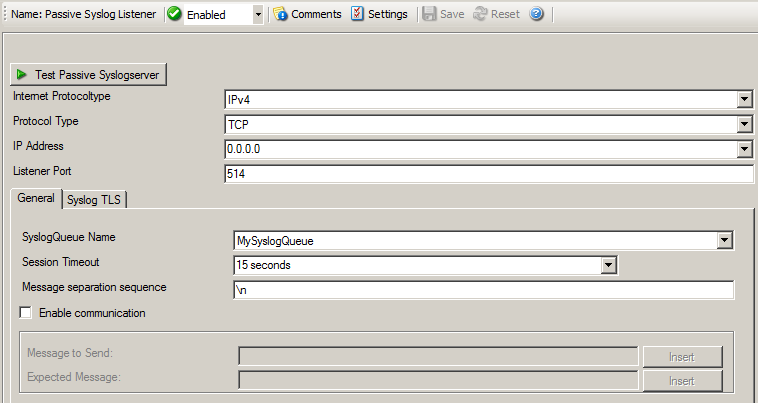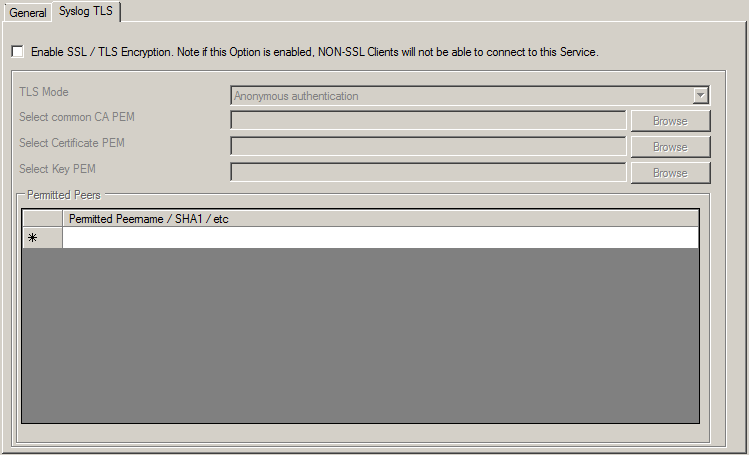The Passive Syslog Listener Service is basically a TCP based Listener Service that sends messages from a Syslog Queue to any remote host, that connects to it. Connections can be secured with TLS including certificate based authentication. A preconfigured greating and response message may also be configured.

Syslog Server Properties
Internet Protocol Type
Select the desired protocol type. IPv4 and IPv6 are available. The IPv6 protocol needs to be properly installed in order to be used. Note that one Service can only handle IPv4 or IPv6, so if you want to use both protocols, you will need to create two separate services.
Currently only TCP is supported for the Passive Syslog Listener.
IP Address
The Syslog Server can now be bound to a specific IP Adress. You can either use an IPv4, an IPv6 Address or a Hostname that resolves to an IPv4 or IPv6 Address. This feature is useful for multihome environments where you want to run different Syslog Servers on different IP Addresses. Please note that the default IP Address 0.0.0.0 means ANY IPv4 Address and "::" means all available IPV6 Addresses..
The port the Syslog server listens on. The typical (standard) value is 514. This should be changed only if there is a definite need for it. Such a need typically arises from security concerns. If the port is changed, all reporting devices (routers, printers …) must also be configured to use the non-standard port.
General Options
SyslogQueue Name
Selects the SyslogQueue to be used by this Service. Must be set to a valid
SyslogQueue. See SyslogQueue Action for more about Syslog Queues.
Session Timeout
One of the TCP-specific options is the session timeout. This value declares, how long a TCP session may be kept open, after the last package of data has been sent. You can by default set values between 1 second and 1 day. Or you can use a custom value with a maximum of 2147483646 milliseconds. If you wish to disable the session timeout, you can use a custom value of 0 milliseconds to disable it.
Message separation sequence
This determines, how you want to separate the messages. By default "\r\n" is the value for this, as most times a message ends with a carriage return and/or a line feed. But, you can choose your own separation sequence here as well.
Enabled communication
Activate this setting when you want to Send and Receive an expected
message after the connection is established.
Message to Send
Defines the message send to the Client after the connection is
established. The Passive Syslog Listener will close the connection if the
message does not match.
Expected Message
Defines the message to be expected from the Client after our message was
send. The Passive Syslog Listener will close the connection if the message
does not match.
Syslog TLS

SSL/TLS Options
Enable SSL / TLS Encryption
This option enables SSL / TLS encryption for your syslog server. Please note, that with this option enabled, the server only accepts SSL / TLS enabled senders.
TLS Mode
The TLS mode can be set to the following:
Anonymous authentication
Default option, which means any client certificate will be accepted, or even none.
x509/name (certificate validation and name authentication)
When this mode is selected, the subject within the client certificate will be checked against der permitted peers list. This means the Syslog Server will only accept the secured connection if it finds the permitted peer in the subject.
509/fingerprint (certificate fingerprint authentication)
This mode creates a SHA1 Fingerprint from the client certificate it receives, and compares it to fingerprints from the permitted peers list. You can use the debuglog to see fingerprints of client certificates which were not permitted.
x509/certvalid (certificate validation only)
A Syslog Sender is accepted when the client certificate is valid. No further checks are done.
Select common CA PEM
Select the certificate from the common Certificate Authority (CA), the syslog receiver should use the same CA.
Select Certificate PEM
Select the client certificate (PEM Format).
Select Key PEM
Select the keyfile for the client certificate (PEM Format).
Permitted Peers
This list contains all permitted peers. If x509/name is used, this can contain parts of the client certificate subject. For example if you have CN = secure.syslog.msg in the certificate subject, you can add "secure.syslog.msg" as permitted peer. When using x509/fingerprint, this list holds a list of permitted SHA1 fingerprints. The fingerprints can either be generated with OpenSSL Tools, or grabbed from the debug logfile. The format is like described in RFC 5425, for example: "SHA1:2C:CA:F9:19:B8:F5:6C:37:BF:30:59:64:D5:9A:8A:B2:79:9D:77:A0".
"Test Passive Syslogserver" Button
A new Window opens which will help you testing the Passive Syslogserver.
Make sure the Service is started (Or restarted) after you finished
configuration of the Passive Syslog Listener. The Testwindow will
automatically be filled with correct properties and is ready to go. If the
test succeeds, the datagrid should rapidly fill with queued syslog
messages.
Please Note
Updated the OpenSSL components and libraries with the latest Version openssl-1.0.1j.